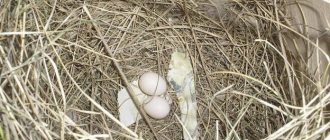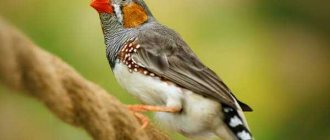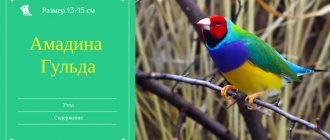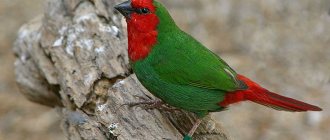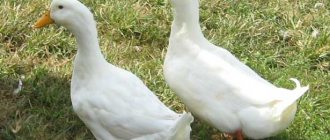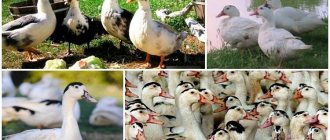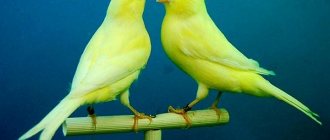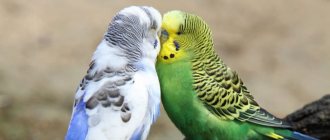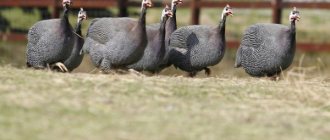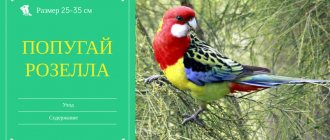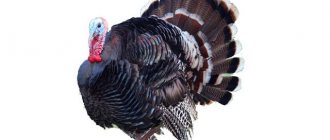Finches are birds from the finch family, which are often kept in captivity. They are small in size, brightly colored and have a pleasant voice. These birds cannot stand being alone, so they are usually kept in pairs or groups. In such conditions, owners often think about starting to breed their pets. Breeding finches at home is a fairly simple task, which nevertheless requires certain measures to be carried out within a specified time frame.
Matching
Successful breeding of finches is impossible without the correct selection of the parent pair. The male and female should be approximately the same age. Amadins become capable of reproduction at 6 months, but to obtain healthy offspring it is better for the birds to be one year old. It is better not to use finches older than 4-5 years for breeding. Old birds often lay unfertilized clutches and take poor care of their chicks. The offspring from such couples are weak and sickly, stunted in growth and often die.
It’s good if the finches chosen as partners live in the same cage and get along peacefully without quarrels or fights. Naturally formed pairs become better parents than those birds that were not previously familiar with each other.
Future parents must be healthy, active, have a neat appearance and bright plumage. The following signs indicate unhealthy birds:
- ruffled feather cover;
- receding hairline;
- discharge from the eyes, nostrils and beak;
- growths on the paws;
- dirty feathers around the cloaca;
- modified droppings (too liquid, mixed with mucus, blood or undigested food particles);
- lethargy;
- lack of appetite.
Such birds must be isolated and treated. They can be bred only after complete recovery.
In addition, finches chosen as breeders should not have external defects that can be inherited by offspring. It is important that the male and female are not related; It is better to purchase them from different breeders. The offspring obtained as a result of inbreeding are often weak and nonviable.
For successful breeding, the selected pair of birds should not be molting. It is advisable that their molt is completed recently, and there is enough time before the next one. The process of changing plumage takes a lot of energy from the bird, and at the same time, the ongoing mating season can deplete the finch’s body and lead to illness.
Finches are prone to obesity. Obese birds often refuse to reproduce, and if chicks appear, the offspring may turn out to be weak and sick. Therefore, before the start of the breeding season, the selected pair must be provided with sufficient exercise by placing them in a spacious enclosure.
Description and origin of the breed
Japanese finch birds were obtained by crossing Chinese species of finches with bronze manakins. Latin name - Lonchura striata var. Domestica. The birds came to Europe from the countries of the Far East and were kept as decorative animals.
Tiny decorative birds are wonderful home birds
Despite the rather modest color of the plumage, these representatives of the finch weaver family are popular for cage keeping to this day.
Distinctive features of birds:
- The average body length is up to 11 cm.
- The weight of the bird is 5-11 grams.
- Thick arched beak.
- The plumage is dense.
Note! Birds are allowed to have different colors, females are usually faded, males are more elegant.
The difference between a female and a male
Externally, the birds are similar, but the female’s plumage is more faded, in gray-brown tones. Males are brighter. But this trait cannot be used in chicks, since representatives of both sexes are very similar. To distinguish, they focus on singing. Females cannot sing, but are able to make calling sounds. Males whistle, and during the current they stretch their necks and emit multi-tone trills.
Note! It is difficult for a layman to distinguish a male from a female; it is better to purchase chicks from trusted pet stores.
Very friendly and inquisitive, these birds enjoy being around their own kind.
Varieties
The main classification of finches is by plumage color. The most common are gray and brown individuals. The appearance of white among the chicks is considered a great success - this color is very rare, and therefore valued. Yellow finches are very beautiful, one of the most decorative representatives of the family.
The second division of birds is based on the presence or absence of a crest, cowlicks or curls that decorate the head, neck or scruff of the finch. However, scientists have not been able to understand which gene is responsible for these characteristics to this day.
The right time for breeding
Amadins in captivity are able to bear offspring at any time of the year. The incentive for finches to start breeding is an increase in daylight hours and an increase in temperature, so it is more convenient to plan the appearance of chicks for the summer period. In winter, in order to produce offspring, you will need to additionally illuminate the room with the breeders and ensure that there are no drafts.
A grown chick is still a chick
Zebra finches are ready to reproduce earlier than anyone else - at 3-5 months. This feature of the organism is associated with their way of life in arid natural places. Zebra finches begin nesting as soon as a wet period of weather arrives. To quickly increase the number of livestock, birds begin mating as early as possible. At the same time, they can wait for years for the rainy season.
Domesticated zebrafish do not need premature nesting. Moreover, over time, their body lost some natural properties and ceased to cope well with early reproduction. Birds simply do not have time to become strong enough and reach the required level of sexual development.
Therefore, they begin to be bred at 9-10 months. It is recommended to use other species of finches for breeding no earlier than 12-18 months.
After four years, it is better not to burden the birds with nesting work. The gradual decline of reproductive functions in females and males can lead to the fact that most of the clutch will not be fertilized, the chicks will begin to die right in the egg or be born underdeveloped and weak. Old females may not survive the nesting period and die.
Diet
The basis of the amadine's diet is grain mixtures of 6-8 components. It is convenient to use food for exotic birds sold in pet stores. The diet must include protein-rich foods - boiled eggs, low-fat cottage cheese. During the period of preparation for breeding, producers are fed sprouted grain - it is rich in vitamin E, which has a beneficial effect on the reproductive system of birds. It is useful for both females and males to give calcium-rich supplements - chalk, eggshells or shell rock. Females are also given sulfur-containing supplements and vitamins.
Feeding finches
Their appearance, activity, and life expectancy depend on a properly formulated diet for finches. The basic menu for poultry consists of the following items:
- seeds of flax, hemp, rapeseed, canary grass, meadow grass;
- different types of millet;
- sprouted grain;
- berries (currants, raspberries, cherries);
- fruits (peaches, melon, pear, apples);
- vegetables (cucumbers, cabbage, carrots, beets, tomatoes);
- boiled rice or millet;
- milk or boiled corn.
In addition, finches love to feast on cottage cheese, boiled eggs, dried insects, worms and fish oil. In summer, the bird's diet must include green food, consisting of: lettuce, young nettles, clover, and dandelions.
Dry grain mixture is given to birds daily at the rate of 1 tsp. food for 1 individual. Liquid food can be used several times a week, and green food every other day.
Special vitamins are recommended as a mineral supplement, or use:
- boiled, chopped eggs;
- crushed snail shells;
- sand;
- charcoal;
- bone meal.
Such a diet will help birds receive the right dose of vitamins, carbohydrates and nutrients. It is better to purchase the grain mixture ready-made or on the market.
Attention! Never feed finches papaya, mango, persimmon or avocado. Birds will not be able to properly digest dill, parsley or young onions.
The water in the drinking bowl should be fresh daily, preferably filtered. Instead, you can prepare a kind of compote from water, fruit and citrus juice.
Socket options
The appearance of a nest is a signal for the beginning of the mating season. For a pair of finches, at least 2 nests are installed in the enclosure. Manufacturers themselves choose the appropriate one. You can offer birds the following nest options:
- Open basket. Constructed from willow twigs, vines or hemp rope. Has an open top.
- Closed basket. It is woven from willow twigs. It looks like a ball with a small entrance.
- Open box. Made from plywood. Does not have a front wall. Equipped with a removable lid and has a recess at the bottom.
Basic information
Amadins are small birds, weighing no more than 30 g, belonging to the finch family. The peculiarity of birds is their singing. With their voice, males attract females during the mating season and show others their mood. Their beak is large and black at birth, becoming red over time, closer to an orange hue.
Today, about 40 species of finches are known. Only a few of them are used for domestic keeping: penguins, white, black-headed, silver, zebra.
Fact! The color of the female finches is more subdued so that predators cannot notice her while hatching her eggs.
In captivity, birds live on average 10 years, although there are known cases of finch life expectancy of up to 15 years. This factor is influenced by stress, improper care of birds, injuries and poor living conditions.
Amadins are inquisitive and simple-minded, like children. They quickly get used to people and have good intelligence. Life alone is unbearable for them, they begin to get sick and may even die. They are not afraid of their owners until they want physical contact: to stroke the bird or hold it in their hands. They are not trainable.
Nesting
In the process of breeding finches at home, the owner can observe all stages of nesting. If they proceed correctly, you can count on successful offspring.
Mating games
Before mating, birds organize mating games. During them, the male dances in front of the female, straightens his feathers, treats his partner with pieces of fruit, and may chase her around the enclosure. The female, in response to courtship, dances and whistles.
Nest construction
After the end of the courtship period, the couple begins to build a nest. This process usually takes about a week. At this time, the cage with finches cannot be moved to a new place, otherwise the birds may refuse to breed.
It is necessary to place in advance a sufficient amount of material in the aviary from which the birds can build a nest. Suitable for this purpose:
- twigs;
- moss;
- feathers;
- hay;
- coir;
- pieces of paper.
The materials are laid out along the bottom of the enclosure, pushed between the bars of the cage and placed in the nesting chamber. Birds should not be provided with threads, cotton wool or scraps of fabric. Finches can become entangled in them and damage their legs.
On a note! Once the nest is built, unused materials should be removed. If left in the enclosure, finches may begin to build a new nest, abandoning the first clutch.
Laying and incubating eggs
The female begins laying eggs a week after mating. She lays 1 egg per day. In total, a clutch can contain from 3 to 7 eggs. Incubation of the clutch begins when 2-3 eggs are laid. Both parents incubate the eggs of finches. They take turns leaving the nest, going for food and water. If the female constantly sits on the eggs and does not leave the clutch, the male brings her food to the nest.
During this period, birds should not be disturbed. It is not recommended to make noise, come close to the enclosure or look into the nest. If for any reason you need to move the eggs (for example, to give them to foster parents), you should use a spoon. You should not touch the eggs with your hands, otherwise the birds will refuse to incubate them.
The incubation period for eggs lasts about 14-17 days. During this time, the room with finches must maintain a temperature of at least 20°C and avoid drafts. Air humidity should be at 60-70%.
The appearance of chicks
Amadine chicks hatch on the 15-17th day of incubation. They are blind and covered with gray down. They have luminous markings at the corners of their beaks, which help parents locate chicks in a dark nest.
Care of offspring
Parents feed the chicks with semi-digested food from the crop. During the period of feeding the offspring, it is necessary to increase the supply of soft food to the birds - cottage cheese, boiled eggs, insects.
If the parents refuse to feed the chicks, they will have to be artificially fed. In this case, the chicks are taken from the nest and placed in a box lined with hay or cloth. The top is covered with fabric. The box is placed near a heating source so that the temperature inside it reaches 38°C in the first week of the chicks’ life, 35°C in the second and 25°C in the third. A container of water is placed next to the box to maintain air humidity at 60-70%.
Feeding of the chicks begins after the separation of the original feces. In the first 3 days, food is given every half hour during the day and every 2 hours at night. In the next 4 days, the break between daytime feedings is increased to 1.5 hours, and between night feedings - up to 3 hours. Over the next 8 days, the chicks are fed every 2 hours during the day, and at night they take a break from 0:00 to 6:00. In the next 15 days, the intervals between daily feedings are increased to 4 hours.
For feeding, use infant formula without milk or special food for chicks. The food should have a liquid consistency and a temperature of 39°C. It is given to chicks using a disposable syringe without a needle.
Attention! Cleaning of the aviary with chicks is carried out 2 weeks after their hatching. If you start cleaning the enclosure before this time, the parents may abandon the chicks.
At the age of 20 days, the chicks begin to fly out of the nest. They begin to feed on their own at the age of 1 month. To accustom the chicks to adult food, they are first given boiled sweetened millet. After 7 days they are offered wet mash, and after another week - sprouted grain and grass seeds.
After the chicks have completely switched to feeding on their own, they must be removed from their parents. Adult finches begin to prepare for a new clutch and may peck at their first brood.
Cell selection
The main thing a person should do before purchasing a finch is to purchase a suitable cage. Since we are talking about a rather energetic species of birds, their permanent residence area should be spacious and comfortable. It is better to take a rectangular cage in shape, so that if desired, finches can hide in a secluded corner. There should be nothing sharp inside that could injure the birds. It is important to choose an option with a door with a secure lock so that birds cannot open it while playing.
The distance between the rods is 1-1.5 cm. It is best to choose a cage made of plastic, glass, polycarbonate or wood. Products with a paint coating, copper or zinc are prohibited. If you plan to have a lot of birds, instead of a cage you can arrange a spacious aviary, focusing on the selection parameters already outlined.
Fact! For two birds you will need a cage measuring at least 60cmx40cmx50cm.
Birds should have the following elements in their cage:
- 2-3 feeders for main food, vegetable or fruit supplements and mineral mixtures;
- closed or open drinking bowl made of plastic, glass or porcelain;
- perch - a perch made of wood where birds will spend most of their time; It is best to choose perches from disinfected wood so that the birds cannot injure their paws during activity;
- mineral stone necessary for cleaning the beak and enriching food with important microelements (phosphorus, iodine, iron, zinc);
- nest if you plan to breed finches; you can make it yourself or buy it at a pet store; placement - in a secluded corner of the cage;
- hanging bathing suit for cleaning pet feathers, no more than 2 cm deep, made of glass or porcelain;
- toys to keep the birds entertained - a plastic chain, a rocker, a mirror.
Another important question is where exactly to place the cage so that the birds are comfortable. Usually the birds are moved closer to the window, but so that they are not exposed to direct sunlight. Finches should have at least 12 hours of daylight, after which they are usually covered with a thick blanket. In winter, to ensure the required time of light activity, a fluorescent lamp is installed next to the cage.
To prevent the birds from catching a cold, their house should be located away from drafts, next to the wall on a slight elevation (not on the floor). The optimal temperature is +24 degrees, humidity is up to 70%.
Possible problems
One of the possible complications of breeding finches is the egg getting stuck in the female’s oviduct at the time of laying. This problem occurs in emaciated birds, with a lack of minerals and the presence of diseases of the internal organs. In the absence of timely assistance, the bird may die.
Some birds abandon their clutches if disturbed while incubating. In this case, it is necessary to remove the eggs and place them in an incubator or give them to foster parents with a well-developed brooding instinct, for example, Japanese finches.
Golden rules of breeding
Selection of a pair is an important point in breeding finches. To become the happy owner of healthy and strong chicks, you must select healthy and strong parents in advance. You can determine whether a bird is suitable for breeding by taking a closer look at its behavior and conducting a visual inspection.
When making pairs, keep in mind that it is not recommended to cross close relatives or different species of finches. Experienced breeders do this kind of work, trying to fix the desired quality in birds. For you, such experiments are meaningless. In addition, you risk getting frail chicks with various pathologies.
Moulting birds should not be mated. During molting, they experience serious stress. Wait a month after the end of the process, when the bird’s body returns to normal.
During the nesting period, finches need additional vitamins, macro- and microelements, proteins, mineral supplements and other useful and nutritious substances. Nesting birds are fed a special “mash”, the recipe for which you will find in the article “What to feed finches.”
Mating games - a signal to install a nest
After a successful acquaintance, the male begins to court the female: feeding her, singing short songs or making characteristic sounds.
Then the finches begin the so-called mating games. Males perform ritual dances, fluff up their plumage, showing the bride all their talents. Females nod in response, dance along, and make short, quiet sounds.
But male parrot finches do not have a “wedding dance” in their arsenal of love. They simply chase their partners around the entire cage, performing simple songs.
If you notice that the birds are engaged in mating games, install a nesting base in the cage. The article “Nest for finches” will help you choose the right one. If you don't know where it is more convenient for your pets to nest, give them two or three options to choose from.
After installing the nesting base, you must not move the cage, otherwise you can throw off the birds’ entire love mood. Therefore, install it in advance in the brightest place in the room, at a height of one and a half meters from the floor, where there are no drafts.
In order for the birds to build a nest to their liking, you must provide them with building material: hay, soft blades of grass, sisal, coconut fiber, small feathers, paper torn into shreds.
Lay it all out at the bottom of the cage, insert it between the rods, and place it in the nesting base itself. Under no circumstances give finches threads, scraps of fabric, or cotton wool. In such material, chicks risk becoming entangled, injured or suffocated. If the parents get caught, they may accidentally step on the egg or crush the chick.
